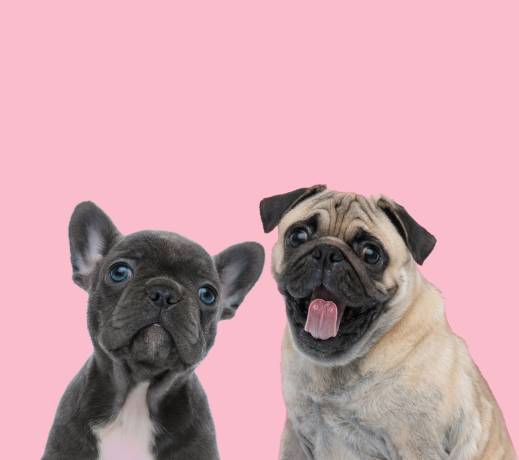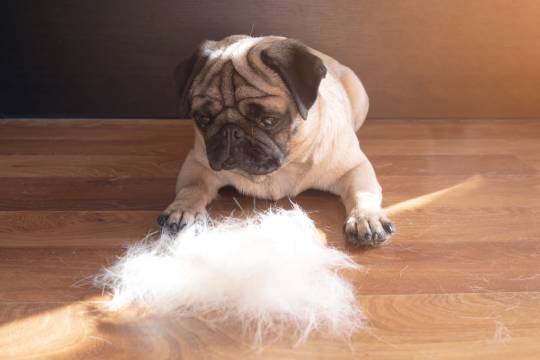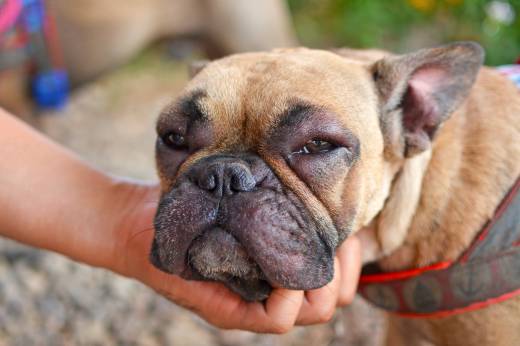Have you recently adopted a Pug and are wondering how to care for him? If so, then you’ve come to the right place!
Connect with a verified veterinarian in minutes. Licensed vets are available 24/7 to answer your questions. No need to worry about your furry family member.
In this article, we’ve put together some information about these cute, small dogs and how to care for them. Let’s get started!
What is a Pug?
Did you know that Pugs originally came from China? They are known to have been around way back in the Han Dynasty, which lasted from 206 BC to 200 AD. Some canine experts believe these dogs are related to the Tibetan Mastiff. They were used by Emperors in China as companions and guard dogs. So, these dogs were used to some luxurious living!
Pugs were brought to Europe by Dutch traders, so the story goes. From there, they quickly became a favorite all across Europe. In fact, these small dogs became the official dog of the House of Orange. It’s said a Pug once saved the life of William, the Prince of Orange, letting the prince know the Spanish were on the way in 1572!
These special dogs weren’t brought to the US until after the Civil War. The breed was recognized by the AKC in 1885.
These days, Pugs don’t need a palace to live in; however, they do need plenty of love and attention.
Size & Lifespan
Pugs are usually between 14-18 lbs and stand about 10-14 inches. Their average lifespan is between 12-15 years.

Review symptoms, medications & behavior to keep your pets healthy with a Vet Online in just minutes.
Ask a Vet Live NowPug Characteristics & Personality
Pugs have such cute, wrinkly faces, with big dark eyes! Their faces are round and flat. These little guys are pretty much clowns; however, they do have a surprising amount of dignity, too. They’re playful and love to play games. They also love to be with their humans and be the center of attention. They don’t do well if left alone or not given the right amount of attention.
These are happy small dogs who are very affectionate and loyal. They’re very intelligent, too, and can sometimes be a bit stubborn. This last aspect of their personality can make them a little challenging to train.
Pugs need to be properly trained and socialized, so they get along with other animals and kids. They do well living in apartments, too, as they don’t require a lot of space or tons of activity.
What’s more, because these dogs have a flat face, they don’t do well in extremely hot or cold climates. They need to be kept indoors for this reason.
OK, let’s get on to how to care for these darling little clowns!
Caring for a Pug
Let’s start with feeding your Pug. It’s a fact that these small dogs do love to eat, which can be a bad combination since they’re not very active. The problem is that if Pugs eat too much, they have a tendency to overeat and become obese. So, it’s important to monitor how much your feed your fur baby, and then make sure he has some exercise every day to keep from gaining weight.
Pugs also prefer a regular schedule for eating. Vets recommend feeding your Pug about twice a day. When it comes to food, they do best on a dry kibble diet rather than wet dog food. They also enjoy the occasional snack and can be moist. You can also use these snacks to train your canine companion.
Another issue with Pugs is that they tend to have sensitive stomachs. They’re also prone to skin reactions from food additives. So, it’s best to stick to all-natural dog foods that have no preservatives, no artificial flavorings or dyes, no by-products, don’t have high grain counts, generic meats, oils, corn, soy, or other types of fillers.
Because these dogs have flat faces, your Pug will do better with a water bowl and a food bowl that are at floor level. And when Pugs gulp food, it’s best to use a slow feeder bowl. This is because Pubs have a tendency to develop bloat, which can cause twisting of the stomach. This condition can lead to death.
It’s important to also make sure your Pug gets plenty to drink each day. They need to drink about 1.5 to 2 oz of water per pound of body weight per day in order to stay properly hydrated.
Exercise for Your Pug
While Pugs are known for being couch potatoes, you’ll help keep his weight under control by ensuring he has plenty of exercise every day. This means about 20 minutes of exercise twice a day. That’s enough to keep these little dogs in shape!
Exercise can include walks and playtime. And it’s also beneficial to provide plenty of toys for these intelligent dogs. The toys keep them busy and out of trouble!
One thing to note about exercising your Pug; because they are brachycephalic, they have a very hard time breathing in the heat. It’s harder for them to cool down than it is for other dog breeds. Humid days also make it difficult for them to breathe. For these reasons, you’ll need to be careful about exercising your fur baby on hot, humid days.
Grooming Your Pug
Pugs are known for shedding quite a bit, even though their hair is short. So, expect to vacuum quite a bit if you have a Pug.
Your fur baby will need to be bathed about once a month or when he’s very dirty and smelly. When bathing your Pug, pay special attention to their folds. You’ll need to keep these areas clean to avoid skin and yeast infections. So, be sure to dry the folds well after a bath or washing your canine companion’s face.
Even though Pugs have short hair, they still require brushing about twice a week. This helps keep their coat shiny and healthy and helps to control some of the shedding.
So, there you have it! Pugs are beautiful little dogs who require some specialized care. However, they’ll be your best bud for their entire life! Give your Pug the right care, and he’ll have a long, happy life with you!
Connect with a verified veterinarian in minutes. Licensed vets are available 24/7 to answer your questions. No need to worry about your furry family member.

Tom
Tom has always loved to write since he was little - he wanted to be either a writer or a veterinary doctor, but he ended up being a professional writer while most of his works are based on animals. He was born in San Francisco but later moved to Texas to continue his job as a writer. He graduated from the University of San Francisco where he studied biotechnology. He is happily married and a soon to be father!
Review symptoms, medications & behavior to keep your pets healthy with a Vet Online in just minutes.
Ask a Vet Live Now



